Updated on August 11th, 2022 by Bob Ciura
Spreadsheet data updated daily
Master Limited Partnerships – or MLPs, for short – are some of the most misunderstood investment vehicles in the public markets. And that’s a shame, because the typical MLP offers:
- Tax-advantaged income
- High yields well in excess of market averages
- The bulk of corporate cash flows returned to shareholders through distributions
An example of a ‘normal’ MLP is an organization involved in the midstream energy industry. Midstream energy companies are in the business of transporting oil, primarily though pipelines. Pipeline companies make up the vast majority of MLPs.
Since MLPs widely offer high yields, they are naturally appealing for income investors. With this in mind, we created a full downloadable list of nearly 100 MLPs in our coverage universe.
You can download the Excel spreadsheet (along with relevant financial metrics like dividend yield and payout ratios) by clicking on the link below:
This comprehensive article covers MLPs in depth, including the history of MLPs, unique tax consequences and risk factors of MLPs, as well as our 7 top-ranked MLPs today.
The table of contents below allows for easy navigation of the article:
Table of Contents
The History of Master Limited Partnerships
MLPs were created in 1981 to allow certain business partnerships to issue publicly traded ownership interests.
The first MLP was Apache Oil Company, which was quickly followed by other energy MLPs, and then real estate MLPs.
The MLP space expanded rapidly until a great many companies from diverse industries operated as MLPs – including the Boston Celtics basketball team.
One important trend over the years, is that energy MLPs have grown from being roughly one-third of the total MLP universe to containing the vast majority of these securities.
Moreover, the energy MLP universe has evolved to be focused on midstream energy operations. Midstream partnerships have grown to be roughly half of the total number of energy MLPs.
MLP Tax Consequences
Master limited partnerships are tax-advantaged investment vehicles. They are taxed differently than corporations. MLPs are pass-through entities. They are not taxed at the entity level.
Instead, all money distributed from the MLP to unit holders is taxed at the individual level.
Distributions are ‘passed through’ because MLP investors are actually limited partners in the MLP, not shareholders. Because of this, MLP investors are called unit holders, not shareholders.
And, the money MLPs pay out to unit holders is called a distribution (not a dividend).
The money passed through from the MLP to unit holders is classified as either:
MLPs tend to have lots of depreciation and other non-cash charges. This means they often have income that is far lower than the amount of cash they can actually distribute. The cash distributed less the MLPs income is a return of capital.
A return of capital is not technically income, from an accounting and tax perspective. Instead, it is considered as the MLP actually returning a portion of its assets to unit holders.
Now here’s the interesting part… Returns of capital reduce your cost basis. That means taxes for returns of capital are only due when you sell your MLP units. Returns of capital are tax-deferred.
Note: Return of capital taxes are also due in the event that your cost basis is less than $0. This only happens for very long-term holding, typically around 10 years or more.
Each individual MLP is different, but on average an MLPs distribution is usually around 80% to 90% a return of capital, and 10% to 20% ordinary income.
This works out very well from a tax perspective. The images below compare what happens when a corporation and an MLP each have the same amount of cash to send to investors.
Note 1: Taxes are never simple. Some reasonable assumptions had to be made to simplify the table above. These are listed below:
- Corporate federal income tax rate of 21%
- Corporate state income tax rate of 5%
- Qualified dividend tax rate of 20%
- Distributable cash is 80% a return of capital, 20% ordinary income
- Personal federal tax rate of 22% less 20% for passive entity tax break
(19.6% total instead of 22%) - Personal state tax rate of 5% less 20% for passive entity tax break
(4% total instead of 5%) - Long-term capital gains tax rate of 20% less 20% for passive entity tax break
(16% total instead of 20%)
Note 2: The 20% passive income entity tax break will expire in 2025.
Note 3: In the MLP example, if the maximum personal tax rate of 37% is used, the distribution after all taxes is $8.05.
Note 4: In the MLP example, the accrued cost basis reduction tax is due when the MLP is sold, not annually come tax time.
As the tables above show, MLPs are far more efficient vehicles for returning cash to shareholders relative to corporations. Additionally, in the example above $9.57 out of $10.00 distribution would be kept by the MLP investor until they sold because the bulk of taxes are from returns of capital and not due until the MLP is sold.
Return of capital and other issues discussed above do not matter when MLPs are held in a retirement account.
There is a different issue with holding MLPs in a retirement account, however. This includes 401(k), IRA, and Roth IRA accounts, among others.
When retirement plans conduct or invest in a business activity, they must file separate tax forms to report Unrelated Business Income (UBI) and may owe Unrelated Business Taxable Income (UBTI). UBTI tax brackets go up to 37% (the top personal rate).
MLPs issue K-1 forms for tax reporting. K-1s report business income, expense, and loss to owners. Therefore, MLPs held in retirement accounts may still qualify for taxes.
If UBI for all holdings in your retirement account is over $1,000, you must have your retirement account provider (typically, your brokerage) file Form 990-T.
You will want to file form 990-T as well if you have a UBI loss to get a loss carryforward for subsequent tax years. Failure to file form 990-T and pay UBIT can lead to severe penalties.
Fortunately, UBIs are often negative. It is a fairly rare occurrence to owe taxes on UBI.
The subject of MLP taxation can be complicated and confusing. Hiring a tax professional to aid in preparing taxes is a viable option for dealing with the complexity.
The bottom line is this: MLPs are tax-advantaged vehicles that are suited for investors looking for current income. It is fine to hold them in either taxable or non-taxable (retirement) accounts.
Since retirement accounts are already tax-deferred, holding MLPs in taxable accounts allows you to ‘get credit’ for the full effects of their unique structure.
4 Advantages & 6 Disadvantages of Investing in MLPs
MLPs are a unique asset class. As a result, there are several advantages and disadvantages to investing in MLPs. Many of these advantages and disadvantages are unique specifically to MLPs.
Advantages of MLPs
Advantage #1: Lower taxes
MLPs are tax-advantaged securities, as discussed in the “Tax Consequences” section above. Depending on your individual tax bracket, MLPs are able to generate around 40% more after-tax income for every pre-tax dollar they decide to distribute, versus Corporations.
Advantage #2: Tax-deferred income through returns of capital
In addition to lower taxes in general, 80% to 90% of the typical MLPs distributions are classified as returns of capital. Taxes are not 0wed (unless cost basis falls below 0) on return of capital distributions until the MLP is sold.
This creates the favorable situation of tax-deferred income.
Tax-deferred income is especially beneficial for retirees as return on capital taxes may not need to be paid throughout retirement.
Advantage #3: Diversification from other asset classes
Investing in MLPs provides added diversification in a balanced portfolio. Diversification can be measured by the correlation in return series between asset classes.
MLPs are excellent diversifiers, having either a near zero or negative correlation to corporate bonds, government bonds, and gold.
Additionally, they have a correlation coefficient of less than 0.5 to both REITs and the S&P 500. This makes MLPs an excellent addition to a diversified portfolio.
Advantage #4: Typically very high yields
MLPs tend to have high yields far in excess of the broader market. As of this writing, the S&P 500 yields ~2.1%, while the Alerian MLP ETF (AMLP) yields over 25%. Many individual MLPs have yields above 10%.
Disadvantages of MLPs
Disadvantage #1: Complicated tax situation
MLPs can create a headache come tax season. MLPs issue K-1’s and are generally more time-consuming and complicated to correctly calculate taxes than ‘normal’ stocks.
Disadvantage #2: Potential additional paperwork if held in a retirement account
In addition, MLPs create extra paperwork and complications when invested through a retirement account because they potentially create unrelated business income (UBI). See the “Tax Consequences” section above for more on this.
Disadvantage #3: Little diversification within the MLP asset class
While MLPs provide significant diversification versus other asset classes, there is little diversification within the MLP structure.
The vast majority of publicly traded MLPs are oil and gas pipeline businesses. There are some exceptions, but in general MLP investors are investing in energy pipelines and not much else.
Because of this, it would be unwise to allocate all or a majority of one’s portfolio to this asset class.
Disadvantage #4: Incentive Distribution Rights (IDRs)
MLP investors are limited partners in the partnership. The MLP form also has a general partner.
The general partner is usually the management and ownership group that controls the MLP, even if they own a very small percentage of the actual MLP.
Incentive Distribution Rights, or IDRs, are used to ‘incentivize’ the general partner to grow the MLP.
IDRs typically allocate greater percentages of cash flows to go to the general partner (and not to the limited partners) as the MLP grows its cash flows.
This reduces the MLPs ability to grow its distributions, putting a handicap on distribution increases.
It should be noted that not all MLPs have IDRs, but the majority do.
Disadvantage #5: Elevated risk of distribution cuts due to high payout ratios
One of the big advantages of investing in MLPs is their high yields. Unfortunately, high yields very often come with high payout ratios.
Most MLPs distribute nearly all of the cash flows they make to unit holders. In general, this is a positive.
However, it creates very little room for error.
The pipeline business is generally stable, but if cash flows decline unexpectedly, there is almost no margin of safety at many MLPs. Even a short-term disturbance in business results can necessitate a reduction in the distribution.
Disadvantage #6: Growth Through Debt & Share Issuances
Since MLPs typically distribute virtually all of their cash flows as distributions, there is very little money left over to actually grow the partnership.
And most MLPs strive to grow both the partnership, and distributions, over time. To do this, the MLP’s management must tap capital markets by either issuing new units or taking on additional debt.
When new units are issued, existing unit holders are diluted; their percentage of ownership in the MLP is reduced.
When new debt is issued, more cash flows must be used to cover interest payments instead of going into the pockets of limited partners through distributions.
If an MLPs management team starts projects with lower returns than the cost of their debt or equity capital, it destroys unit holder value. This is a real risk to consider when investing in MLPs.
The 7 Best MLPs Today
The 7 best MLPs are ranked and analyzed below using expected total returns from the Sure Analysis Research Database. Expected total returns consist of 3 elements:
- Return from change in valuation multiple
- Return from distribution yield
- Return from growth on a per-unit basis
The top MLPs list was screened further on a qualitative assessment of a company’s dividend risk.
Specifically, MLPs with a Dividend Risk score of ‘F’ according to the Sure Analysis Research Database were omitted from the list.
Additionally, MLPs with current distribution yields below 2% were not considered. This screen makes the list more attractive to income investors.
Continue reading for detailed analysis on each of our top MLPs, ranked according to expected 5-year annual returns, but also ranked further by debt levels and strength of assets.
MLP #7: Sunoco LP (SUN)
- 5-year expected annual returns: 11.3
Sunoco distributes fuel products through its wholesale and retail business units. The wholesale unit purchases fuel products from oil refiners and sells those products to both its own and independently-owned dealers.
The retail unit operates stores where fuel products as well as other products such as convenience products and food are sold to customers.
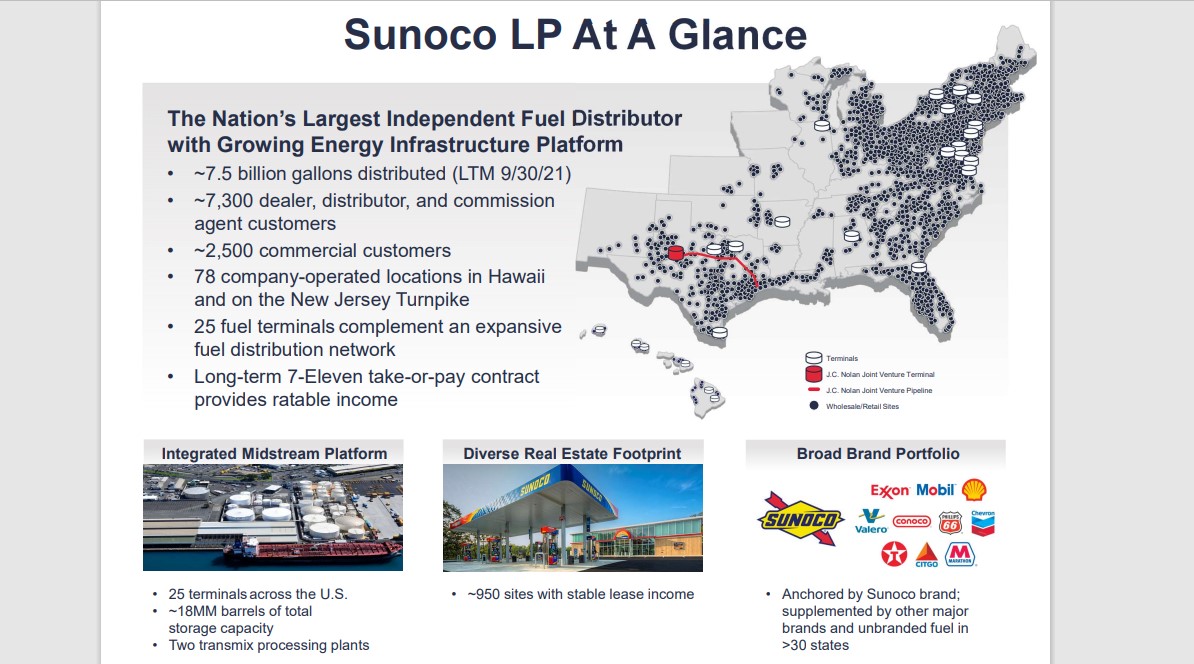
Source: Investor Presentation
Sunoco reported its second quarter earnings results on August 4th. Revenue of $7.82 billion rose 78% year-over-year, and beat analyst estimates by $2.19 billion. Earnings-per-share of $1.20 beat by $0.14 per share. The company reported adjusted EBITDA of $214 million and distributable cash flow of $159 million as adjusted. Sunoco maintained a quarterly distribution of 1.83x, with a quarter-end leverage ratio of 4.17x.
For 2022, Sunoco is forecasting EBITDA of around $795 million to $835 million, representing growth of around 10% versus 2021.
We expect annual returns of 11.3% per year for Sunoco, consisting of 1.5% DCF-per-unit growth, the 8.2% yield, and a small boost from an expanding valuation multiple.
Click here to download our most recent Sure Analysis report on Sunoco (preview of page 1 of 3 shown below):
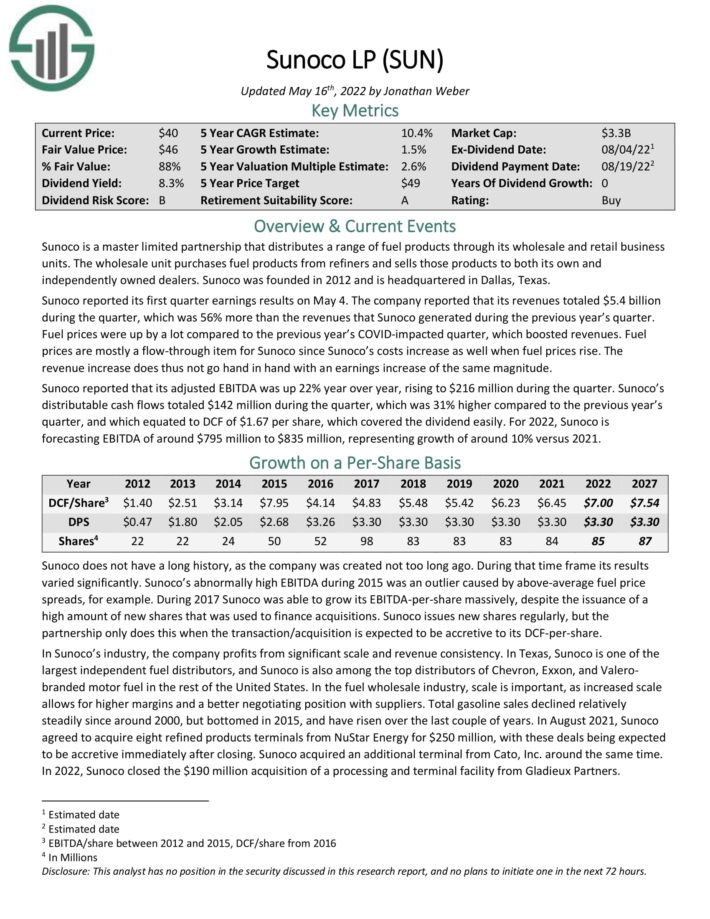
MLP #6: Lazard Ltd. (LAZ)
- 5-year expected annual returns: 12.5%
Lazard is one of the few MLPs that does not operate in the energy sector. Instead, is an international investment advisory company that traces its history to 1848.
The company has two business segments that are Financial Advisory and Asset Management. The Financial Advisory business includes M&A, debt restructuring, capital raising, and other advisory business. The Asset Management business is about 80% equities and focuses primarily on institutional clients.
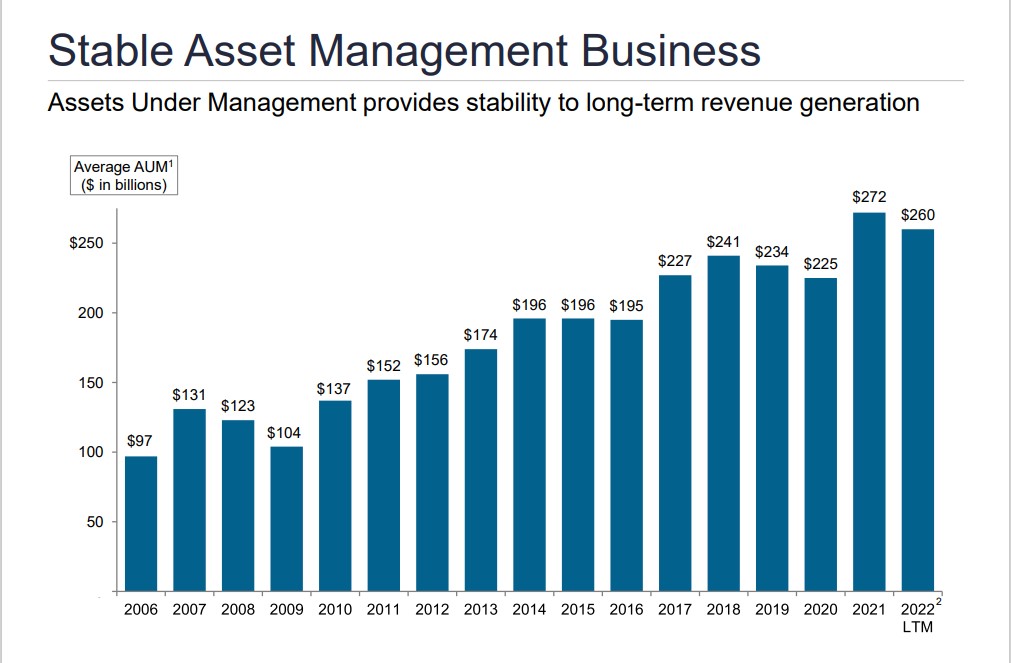
Source: Investor Presentation
Lazard reported Q2 2022 results on July 28th, 2022. Companywide operating revenue decreased (-18%) to $676M from $821M and diluted adjusted earnings per share decreased (-28%) to $0.92 from $1.28 on year-over-year basis on lower M&A deals and debt restructuring and lower assets under management (AUM). Financial Advisory operating revenue was $407M, which was down (-14%) from $471M in the prior year.
Lazard’s top and bottom lines and thus stock price is sensitive to the economic cycle and markets. Lazard is a relatively small player in the asset management business, which is undergoing consolidation. Scale is important in asset management for profitability. Earnings per share declined significantly during the last recession but rapidly recovered.
We expect annual returns of 12.5% per year for Lazard, due to a combination of 5% EPS growth, the 4.9% yield, and a ~2.6% boost from an expanding valuation multiple.
Click here to download our most recent Sure Analysis report on Lazard (preview of page 1 of 3 shown below):
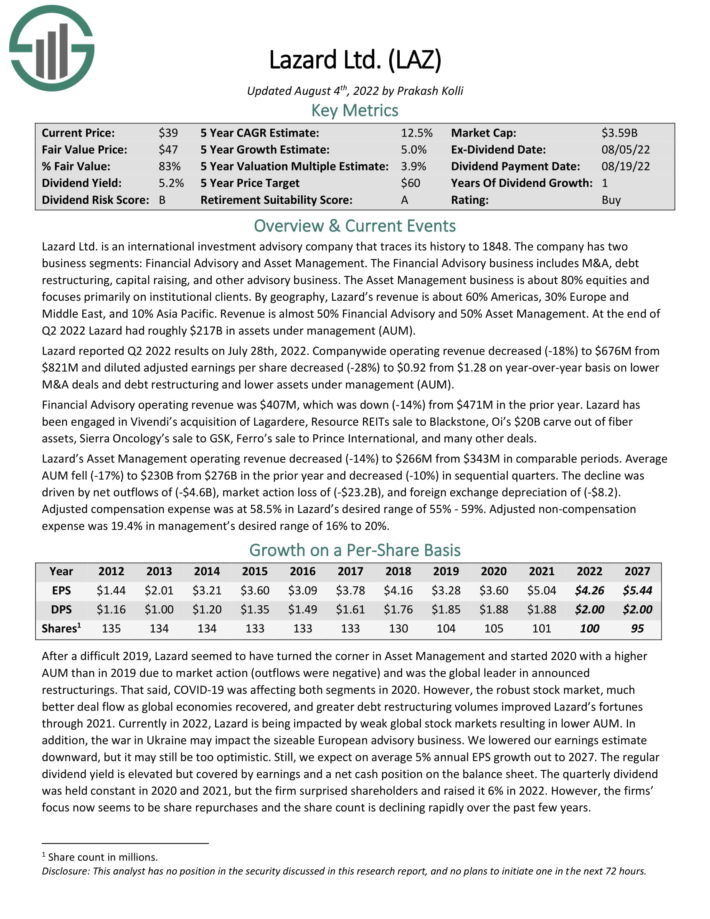
MLP #5: Suburban Propane Partners (SPH)
- 5-year expected annual returns: 13.1%
Suburban Propane has been in operation since 1928 and became a Master Limited Partnership in 1996. The partnership services most of the U.S. with propane and other energy sources, with propane making up around 90% of total revenue. It should generate about $1.3 billion in revenue this year.
The partnership has about 3,200 full-time employees in 41 states, serving approximately 1 million customers.
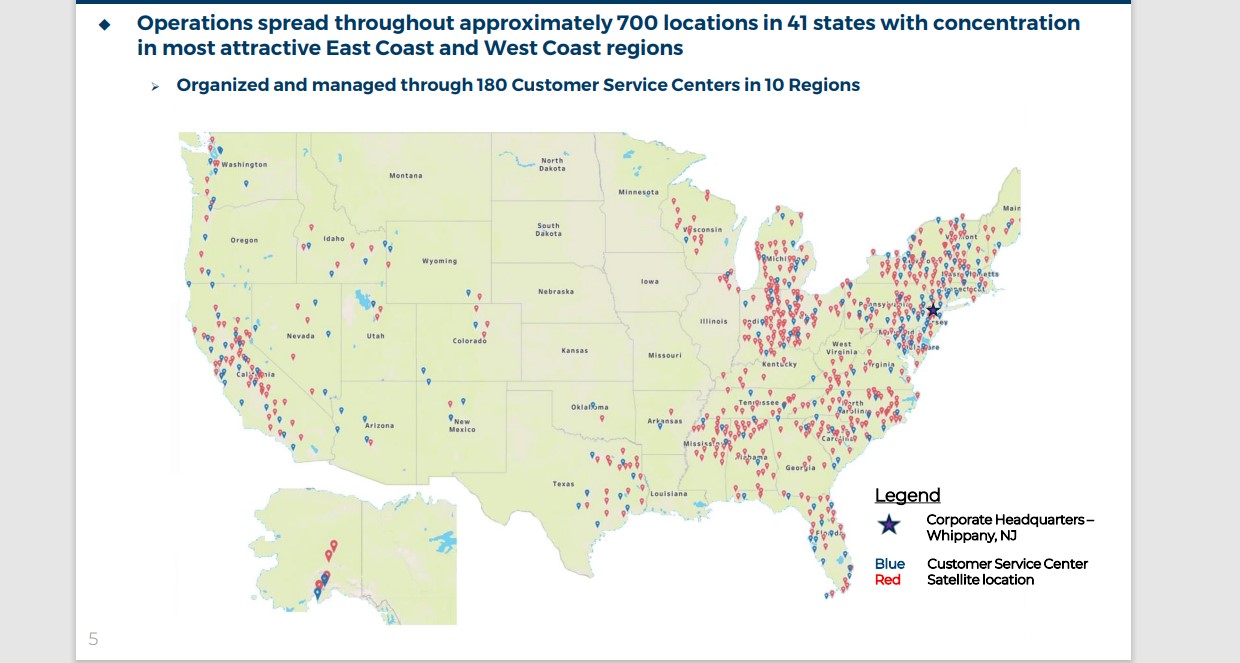
Source: Investor Presentation
Suburban reported third quarter earnings on August 4th, 2022. Quarterly revenue of $300 million rose 26% year-over-year. Gross margin was $159 million, compared with $155 million in the same quarter last year. Adjusted EBITDA increased 25% year-over-year.
We expect 13.1% annual returns for SPH, based on ~1% annual DCF-per-unit growth, the 8.0% distribution yield, and a ~4.1% annual boost from an expanding valuation multiple.
Click here to download our most recent Sure Analysis report on SPH (preview of page 1 of 3 shown below):

MLP #4: Magellan Midstream Partners LP (MMP)
- 5-year expected annual returns: 13.3%
Magellan has the longest pipeline system of refined products, which is linked to nearly half of the total U.S. refining capacity.
This segment generates ~65% of its total operating income while the transportation and storage of crude oil generates ~35% of its operating income. MMP has a fee-based model; only ~9% of its operating income depends on commodity prices.
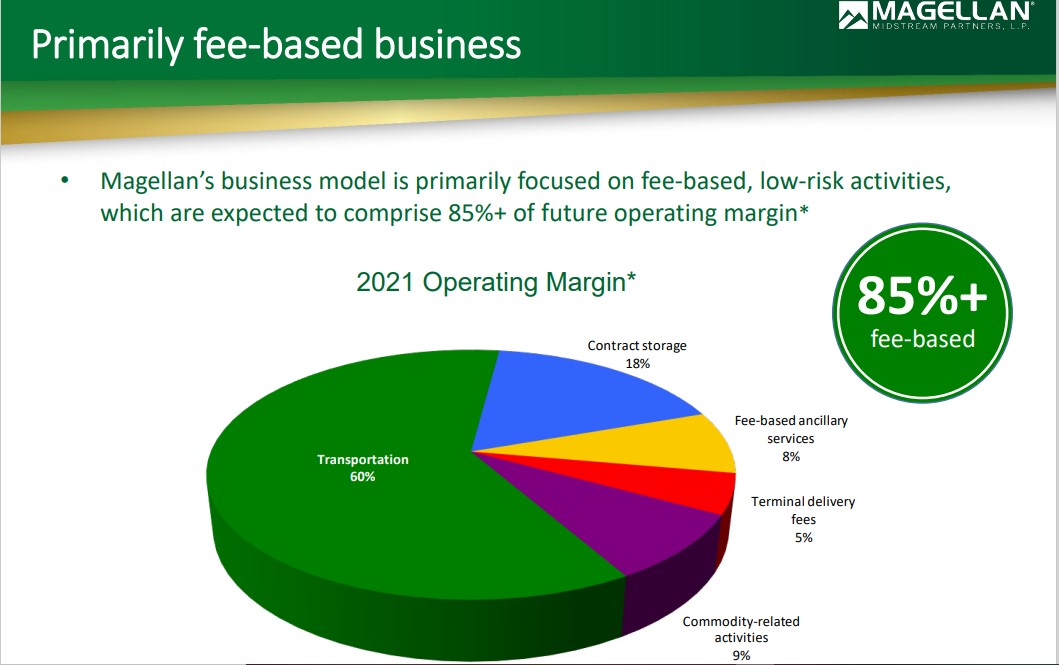
Source: Investor Presentation
In late July, MMP reported (7/28/22) financial results for the second quarter of fiscal 2022. Adjusted earnings-per-share of $1.94 beat analyst estimates by $0.95 per share. Revenue of $789 million for the quarter also beat, by $90 million, and rose 21% year-over-year. The company expects free cash flow of around $1.45 billion for 2022, and approximately $578 million of excess free cash flow after distributions.
The company has a positive growth outlook, due to its lineup of growth projects underway. The company invested has more than $500 million of potential growth projects under consideration. In addition, share repurchases may constitute another significant growth driver.
Click here to download our most recent Sure Analysis report on MMP (preview of page 1 of 3 shown below):
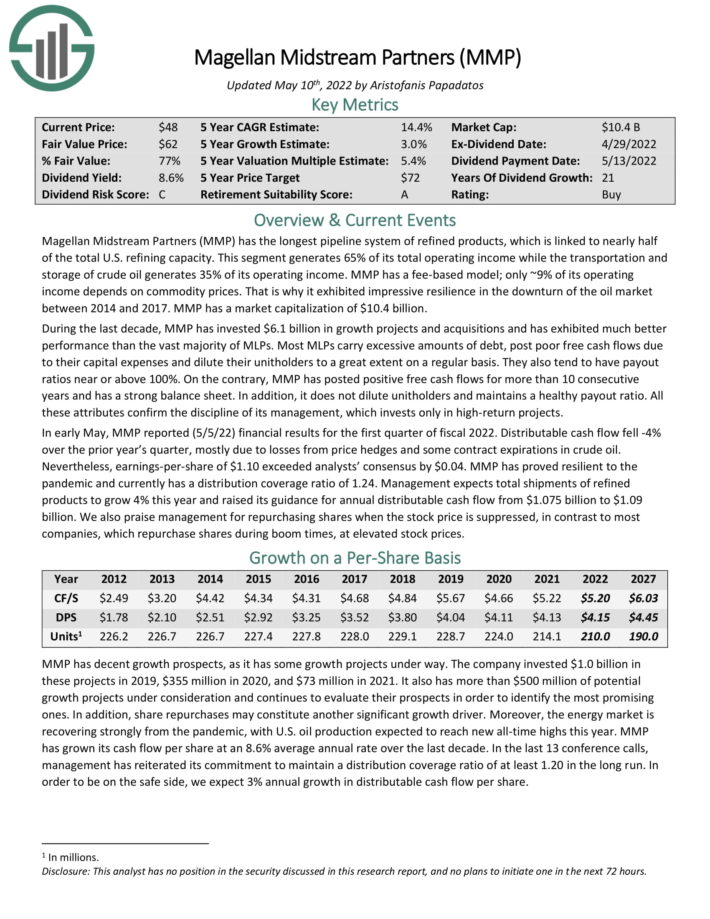
MLP #3: Alliance Resource Partners (ARLP)
- 5-year expected annual returns: 13.8%
Alliance Resource Partners is the first publicly traded master limited partnership and the second-largest coal producer in the eastern United States. Apart from its primary operations of producing and marketing coal to major domestic and international utility users, the company also owns both mineral and royalty interests in premier oil & gas regions, like the Permian, Anadarko, and Williston Basins.
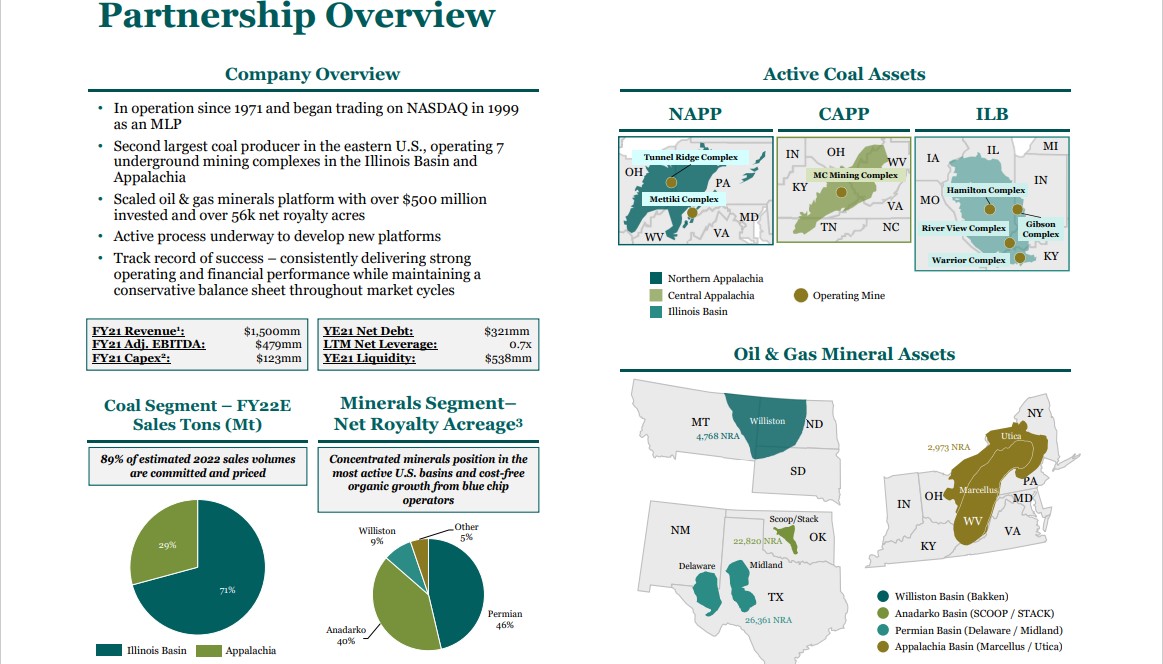
Source: Investor Presentation
Finally, the company provides terminal services, including the transportation and loading of coal and technology products and services. The company generates ~$1.6 billion in annual revenues and is based in Tulsa, Oklahoma.
On July 26th, Alliance Resource Partners raised its distribution by 14.3% to a quarterly rate of $0.40.
On August 1st, 2022, Alliance Resource Partners reported its Q2-2022 results for the period ending June 30th, 2022. Revenues grew by 70.1% year-over-year to $616.5 million. This was the result of higher coal sales prices and volumes, which rose 43.3% and 13.9%, respectively, and higher oil & gas royalty volumes and prices, which increased by 64.7% and 27.6%, respectively.
Specifically, through the efforts of its marketing teams, ARLP continued to benefit from rising coal markets as coal price realizations per ton increased by 43.3% and 25.1% compared to the 2021 and sequential quarters, respectively.
Consequently, EPU surged to $1.23, compared to $0.34 in the comparable period last year. This was despite the impact of inflationary pressures on numerous expense items, including labor-related expenses and supply and transportation costs.
Moving forward, the marketing team continued to add commitments to its coal contract book, entering into new agreements for the delivery of approximately 24.9 million tons over the balance of this year through 2025. With these new contracts, ARLP journeys through 2022 with most of its anticipated coal sales volumes priced and committed. For FY-2022, management expects to sell 35.5 to 37.0 million short tons of coal. Along with the current coal prices and its expected royalties.
We expect total annual returns of 13.8% per year for ARLP, driven by the 5.1% distribution yield, expected annual earnings-per-unit growth of 4%, and a ~4.7% annual boost from an expanding valuation multiple.
Click here to download our most recent Sure Analysis report on ARLP (preview of page 1 of 3 shown below):
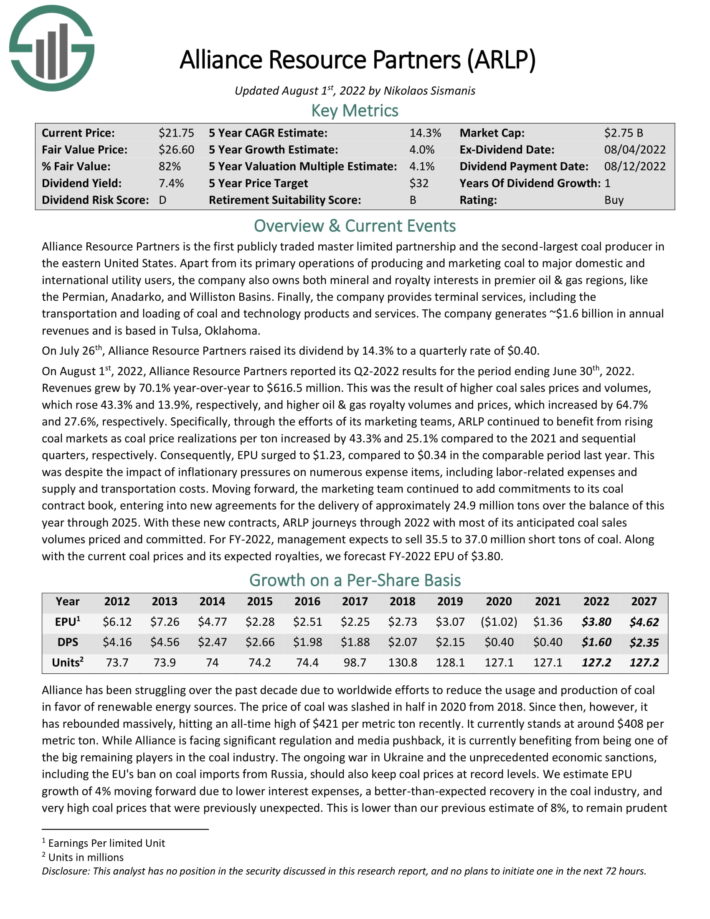
MLP #2: Plains All American Pipeline LP (PAA)
- 5-year expected annual returns: 14.3%
Plains All American Pipeline is a midstream energy infrastructure provider. The company owns an extensive network of pipeline transportation, terminals, storage, and gathering assets in key crude oil and natural gas liquids producing basins at major market hubs in the United States and Canada.
On average, it handles more than 7 million barrels per day of crude oil and NGL through 18,370 miles of active pipelines and gathering systems. Plains All American generates around $40 billion in annual revenues and is based in Houston, Texas.
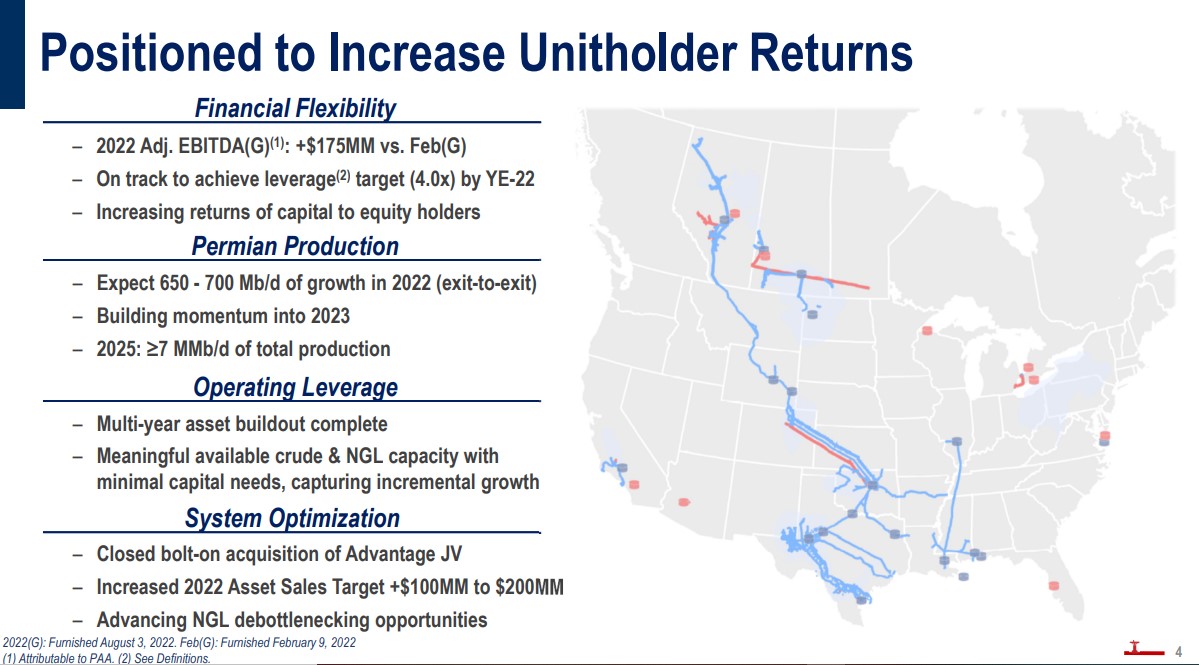
Source: Investor Presentation
On April 6th, 2022, Plains All American hiked its distribution by 21% to a quarterly rate of $0.2175.
On August 3rd, 2022, Plains All American reported its Q2 results for the period ending June 30th, 2022. Revenues came in at $16.4 billion, an increase of 65.6% year-over-year. The significant increase compared to last year was driven by global crude oil demand growing back to near pre-pandemic levels. Higher global oil prices were also a positive contributor, as they nearly doubled year-over-year, with WTI and Brent trading just under $100 a barrel.
Finally, increased production in the Permian Basin significantly boosted results, ending the quarter at roughly 7.4 million barrels a day, compared to 6.0 million barrels in the prior-year period. Distributable cash flows grew 9.6% to $0.57 on a per-unit basis.
During the quarter, the company repurchased $49 million worth of units, which also contributed to the per-share growth of DCF. This brought its cumulative repurchases to around $300 million since November of 2020. Following better than expected results, management increased its fullyear 2022 adjusted EBITDA guidance by $100 million to plus or minus $2.375 billion.
We expect 14.3% annual returns for PAA, driven by the 7.0% yield, as well as 5% annual DCF-per-unit growth and a ~2.3% annual boost from an expanding valuation multiple.
Click here to download our most recent Sure Analysis report on PAA (preview of page 1 of 3 shown below):
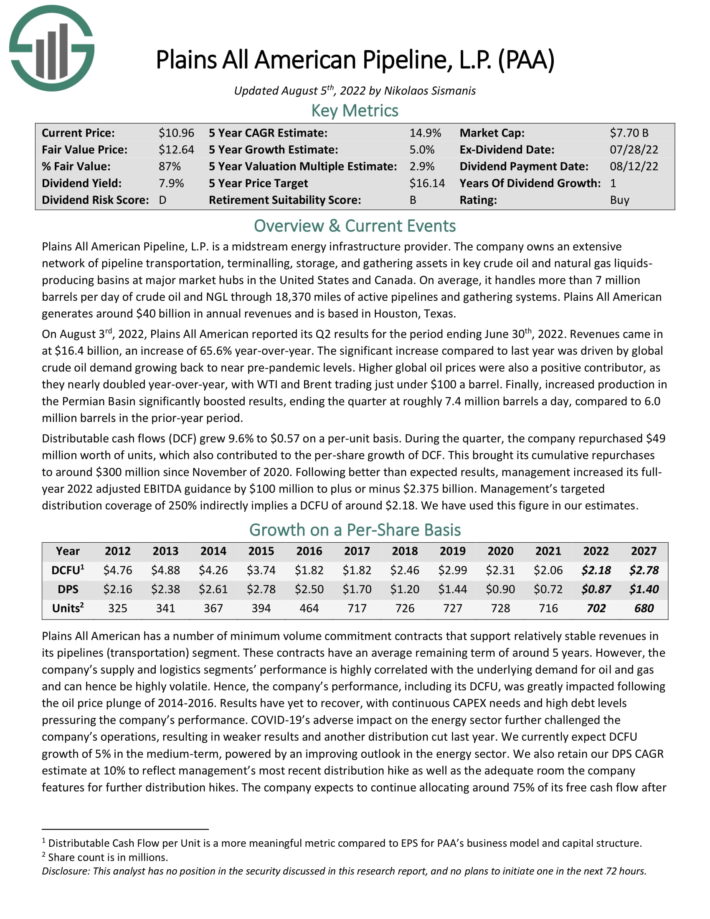
MLP #1: Holly Energy Partners (HEP)
- 5-year expected annual returns: 14.9%
Holly Energy Partners is responsible for transporting and storing crude oil and refined products. The company operates its own crude oil and petroleum pipelines and storage terminals in ten U.S. states, including Texas, Nevada and Washington. HEP also has refinery facilities in Utah and Kansas.
Nearly all the revenues of HEP are fee-based. As a result, in the downturn of the oil market during 2014-2017, while other MLPs saw their earnings collapse, HEP grew its earnings-per-share and its distributable cash flow per share by 76% and 52%, respectively.
On March 14th, 2022, HEP completed the acquisition of the pipelines and terminal assets of Sinclair Transportation. The deal includes 1,200 miles of pipelines of crude oil and products, 8 product terminals and 2 crude terminals. HEP paid $325 million and issued 21 million of common units to pay for the deal, which is valued at $758 million.
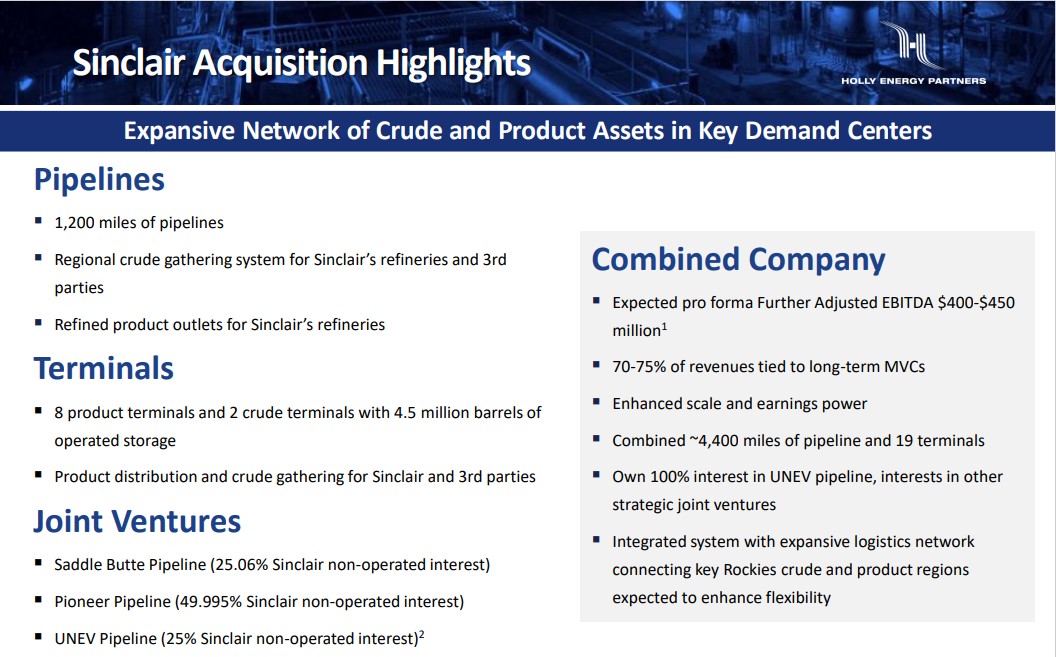
Source: Investor Presentation
In the 2022 second quarter, HEP generated revenue of $135.8 million which rose 7.5% year-over-year. Adjusted EBITDA came to $104.2 million.
Due to the pandemic, HEP cut its quarterly distribution by -48% in 2020, from $0.69 to $0.35, after 60 consecutive quarters without a cut.
However, HEP has recovered strongly from the pandemic, with its current volumes nearly at pre-COVID levels. The resilient DCF of HEP is a testament to the strength of its business model. As HEP currently has a distribution coverage ratio of 1.7, we consider the new distribution safe.
Click here to download our most recent Sure Analysis report on HEP (preview of page 1 of 3 shown below):
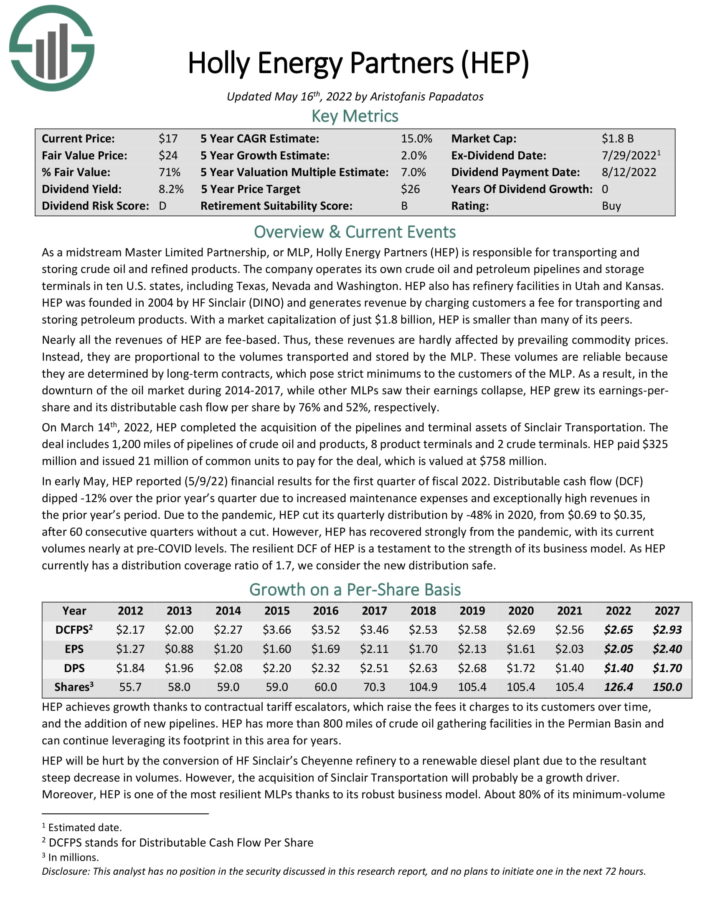
MLP ETFs, ETNs, & Mutual Funds
There are 3 primary ways to invest in MLPs:
- By investing in units of individual publicly traded MLPs
- By investing in a MLP ETF or mutual fund
- By investing in a MLP ETN
Note: ETN stands for ‘exchange traded note’
The difference between investing directly in a company (normal stock investing) versus investing in a mutual fund or ETF is very clear. It is simply investing in one security versus a group of securities.
ETNs are different. Unlike mutual funds or ETFs, ETNs don’t actually own any underlying shares or units of real businesses. Instead, ETNs are financial instruments backed by the financial institution (typically a large bank) that issued them. They perfectly track the value of an index. The disadvantage to ETNs is that they expose investors to the possibility of a total loss if the backing institution were to go bankrupt.
The advantage to investing in a MLP ETN is that distribution income is tracked, but paid via a 1099. This eliminates the tax disadvantages of MLPs (no K-1s, UBTI, etc.). This unique feature may appeal to investors who don’t want to hassle with a more complicated tax situation. The J.P. Morgan Alerian MLP ETN makes a good choice in this case.
Purchasing individual securities is preferable for many, as it allows investors to concentrate on their best ideas. But ETFs have their place as well, especially for investors looking for diversification benefits.
Final Thoughts
Master Limited Partnerships are a misunderstood asset class. They offer diversification, tax-advantaged and tax-deferred income, high yields, and have historically generated excellent total returns. You can download your free copy of all MLPs by clicking on the link below:
The asset class is likely under-appreciated because of its more complicated tax status.
MLPs are generally attractive for income investors, due to their high yields.
As always, investors need to conduct their own due diligence regarding the unique tax effects and risk factors before purchasing MLPs.
The MLPs on this list could be a good place to find long-term buying opportunities among the beaten-down MLPs. To see the highest-yielding MLPs, click here.
Additionally, MLPs are not the only way to find high levels of income. The following lists contain many more stocks that regularly pay rising dividends.
Thanks for reading this article. Please send any feedback, corrections, or questions to [email protected].


